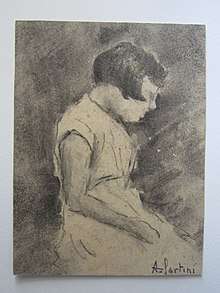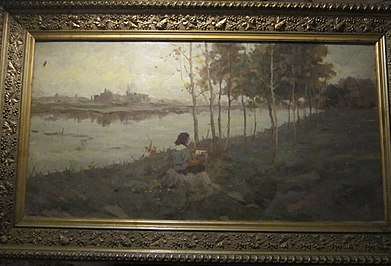Antonino Sartini
Antonino Sartini (Crespellano, 1889 - Bazzano, 7 May 1954) was an Italian painter. He has been called the "painter of serenity"[1] and belongs to that group of landscape painters of the early 1900s, such as Luigi and Flavio Bertelli, Ferruccio Giacomelli, Giovanni Romagnoli, Gino Marzocchi and Garzia Fioresi, who painted the Emilia-Romagna landscapes, reproducing its beauty and witnessing its changes over time, with the paintbrush.[2]
Style

The psychological and aesthetic attitude of many of his works is of a crepuscular matrix, sweetly vespertine. Sartini's painting certainly has something of the Macchiaioli style, as well as undergoing the well-known influences of Bertelli (Luigi and Flavio). In fact, Umberto Beseghi (scholar and historian of the art, contemporary of Sartini) writes:[3]
Antonino Sartini has been called a "Bertelliano". Saying this does not take anything away from him and his art. However, it is also necessary to recognize that he added his own personality to the school of the two great Bolognese painters, his style and that serene goodness that was in his character.
His way of painting is characterized by light touches, round spots, which give a sense of form, without weighing it down with contours or accentuated masses. In many of his works, in fact, everything appears to be intuited in its essence, as hinted at if not even reconstructed and humanized, through a light, never coldly descriptive image of things, where the viewer remains free to complete it and contemplate it with his own feeling. Many of his paintings testify to this, including Bucato al sole from 1930, Paesaggio from 1931, owned by the Gallery of Modern Art in Bologna, Lungo il rio from 1935, and Tessitrice [Weaver] from 1940.[4].

Sartini does not limit himself to painting landscapes, but also portraits. And in the portrait Sartini knows how to grasp that intimate truth that puts the subject out of time: Portrait of Flavio Bertelli of 1931, Nostalgia of 1935, Contemplazione of 1942. About him, Umberto Beseghi (scholar and historian of the art, contemporary of Sartini) wrote in 1956:[5]
There are the landscapes and the figures, which Antonino Sartini knew how to deal with subtle sensitivity, with depth of feeling, with psychological intuition, with that truth that does not deny, [...], but he knows how to transfuse in others what he sees and feels.
References
- "Antonino Sartini".
- "Pittura emiliana - la Repubblica.it". Archivio - la Repubblica.it.
- quote taken from "Catalogo della Mostra postuma del pittore Antonino Sartini 1889 – 1954 a Crespellano, Palazzo municipale", printed by "arti grafiche Minarelli", Bologna, 1970.
- "Antonino Sartini".
- "Antonino e Giuseppe Sartini". www.comune.valsamoggia.bo.it.
External links
- Artisti, on exibart.com.
- Antonino Sartini works on antoninosartini.altervista.org.
- Page of artists of Valsamoggia on comune.valsamoggia.bo.it.
- Antonino Sartini on artifigurative.info.